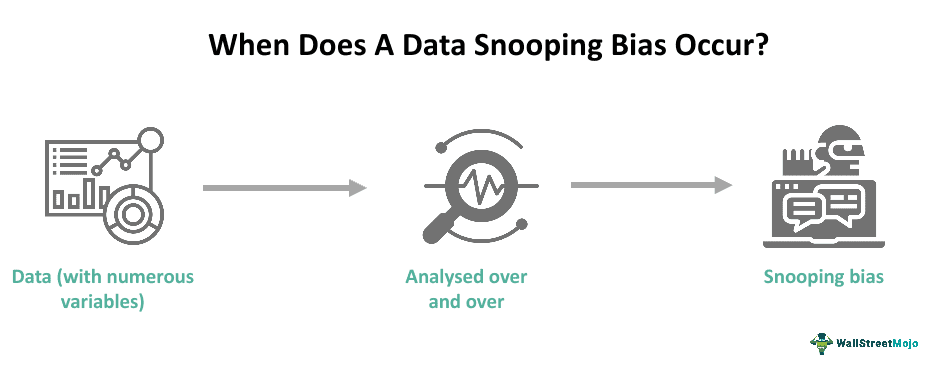Table Of Contents
Data Snooping Bias Meaning
Data Snooping Bias is a type of statistical bias that arises when data containing numerous variables is subjected to statistical analysis. It also occurs when testing is done without a defined a priori hypothesis or proper multiple testing corrections. It has also been observed in situations where researchers use existing studies as a guide for their research.

Data snooping bias occurs when data is overanalyzed, which gives rise to statistically irrelevant and occasionally nonexistent patterns. For instance, investors may repeatedly examine previous investment strategies and a portfolio’s past performance, resulting in bias when making decisions. Keeping these mistakes in check, especially while analyzing financial data, can prevent valuation errors and help reveal the true and fair position of a business.
Key Takeaways
- Data snooping bias is a type of statistical bias usually seen when a large collection of data with numerous variables is subjected to statistical analysis.
- The bias manifests itself when searching exhaustively for combinations of variables; as more combinations are evaluated, the likelihood that a result might have occurred “by chance” increases.
- The two peculiar situations in which data snooping bias most frequently occurs are when researchers adjust the data
- they use to lower the likelihood of a sample rejecting the hypothesis and when researchers have not yet developed an independent hypothesis.
- In-sample and Out-of-sample testing are two methods that help reduce data snooping bias.
Data Snooping Bias Explained
Data Snooping Bias, a statistical bias, surfaces due to the use of incorrect data mining techniques, and it can provide false results in scientific studies. It is also known as data mining bias, data dredging bias, or backtest overfitting. Even though data snooping biases can occur in any industry that uses data mining, they are particularly problematic in finance and medical research because these fields heavily rely on data mining methods.
These erroneous patterns can occasionally be statistically minor and essentially undetectable. However, data snooping biases can be quite significant because minor changes in financial calculations frequently result in extremely large and significant differences in investment performance.
While the practice of employing advanced machine learning models to analyze data has now gained popularity, the chances of data being misused cannot be ignored. Data snooping bias in machine learning can significantly modify or affect results. Such data manipulation may or may not be intentional. However, it can have serious, long-term financial implications for a business.
Data snooping bias usually surfaces when researchers/users search exhaustively for combinations of variables. As more combinations are evaluated, the likelihood that a result might have occurred “by chance” increases. This kind of data snooping bias is seen in two specific situations. The first is when researchers present the data they use in a manner that helps them lower the likelihood of a sample rejecting a particular hypothesis. The second situation is when researchers have not yet developed a hypothesis. In such situations, they are usually open to suggestions presented through data analysis. Unfortunately, there is no way to guarantee that the bias will not occur, but measures can be taken to reduce the possibility of its occurrence.
Examples
The following examples will provide further information and clarity on this concept.
Example #1
Let us assume Dan, a researcher, wants to study the relationship between blood pressure and a specific medication prescribed for diabetes. He has access to a large dataset containing information about patients who suffer from both ailments. Dan readily starts looking for patterns and finds that medicines taken in succession within a certain period produce better effects than those taken separately over longer gaps. After testing, the results confirm his hypothesis. However, Dan had tested multiple hypotheses on the same dataset, which could have given rise to a snooping bias, as he could have simply been looking at it from different perspectives until the same results were achieved.
Example #2
The issue of data snooping bias in financial asset pricing research is highlighted in a study. It examines data snooping bias and demonstrates how it can cause overfitting of the data and erroneous conclusions. The capital asset pricing model (CAPM) and the arbitrage pricing theory (APT) are a few examples of financial asset pricing models that were tested. It also shows how data snooping bias might appear in these tests.
The study finds that data snooping bias is a serious issue in the study of financial asset pricing and suggests measures be taken to reduce its influence on the findings. The report emphasizes the significance of recognizing this bias and adopting measures to lower its influence on the analysis in general. By doing this, researchers can get more reliable findings, which are less likely to be impacted by random chance or false correlations in the data.
How To Avoid?
Backtesting can be an effective solution when researchers wish to address data snooping bias. Apart from software applications that help eliminate such problems, two methods can be used to filter out the errors.
- The first one is called In-sample Testing. It is a data sample/method that backtests the same kind of data that was used to build the in-sample testing model. For example, while working on trading data, it is the data sample used to backtest all combinations arising from the original trading rules.
- The second method is called Out-of-sample Testing. This method is used to test the highest-performing rules (those that were chosen from the in-sample backtesting) on fresh data. Out-of-sample method testing serves as a filter, rejecting the rules that did not perform well in the in-sample test and accepting only the rules that pass both tests.
It is crucial to remember that data snooping bias is not always intentional. Occasionally, it can happen just because an analyst looks through datasets for patterns. It is important to be conscious of this potential bias and take precautions to reduce its influence on the analysis.
